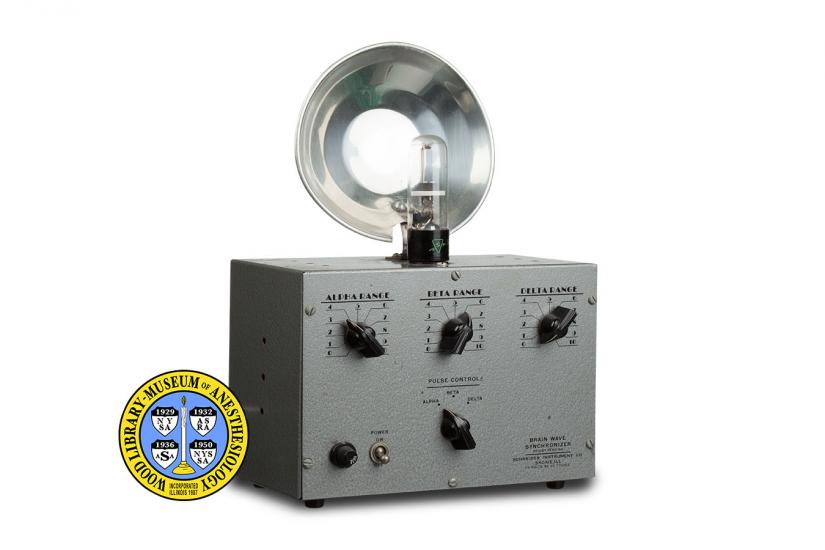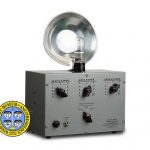Brainwave Synchronizer
The American physician Dr. William S. Kroger (1906-1995) spent his career in obstetrics and in psychology. He had a life-long interest in hypnosis, and was a founding member of several organizations in hypnosis and other fields of alternative (non- traditional) medicine. During WWII he observed that the pulsing lights on a radar screen mimicked the frequencies of brain waves, and could cause a trance in some operators. He later worked with the inventor, Sidney A. Schneider to perfect a machine that could induce hypnosis for medical purposes. They introduced the Brain Wave Synchronizer in 1959. Manufactured by Schneider Instruments Co., it uses a light that flashes at the frequencies of alpha, beta or delta brain waves. In the 1960s, the device was used both to provide analgesia (pain relief) to women in labor, and as an aid to general anesthesia in surgery. It fell out of favor when it was found to induce epileptic seizures. Today, hypnosis is one of the techniques of pain medicine.
Catalog Record: Brainwave Synchronizer
Access Key: akuq
Accession No.: 2003-05-13-1
Title: Brain wave synchronizer / Schneider Instrument Co.
Author: Schneider, Sidney A.
Corporate Author: Schneider Instrument Company.
Title variation: Alt Title
Title: Schneider brain wave synchronizer.
Title variation: Alt Title
Title: Brainwave synchronizer.
Title variation: Alt Title
Title: Schneider apparatus.
Publisher: Skokie, Illinois : Schneider Instrument Co., [between 1958 and 1975].
Physical Descript: 1 cortical synchronizer : metals, plastics, glass, enamel ; 33 x 23 x 17 cm.
Subject: Cortical Synchronization – instrumentation.
Subject: Photic Stimulation – instrumentation.
Subject: Hypnosis.
Note Type: General
Notes: The early year in the date range for the possible year of manufacture is
based on the content and date of the article published by Dr. William S.
Kroger and Sidney A. Schneider in 1959. The end year is an estimate based on
a search for the company’s name and location (Skokie, Illinois) in published
material.
Note Type: Citation
Notes: Bause GS. The Schneider brain wave synchronizer. Anesthesiology.
2010;113(3):584.
Note Type: Citation
Notes: Brain-wave synchronizer aids in hypnosis. Popular Mechanics. October, 1959:84
Note Type: Citation
Notes: The “Brain Wave Synchronizer”–Just a Gimmick? J Am Dent Soc Anesthesiol. May
1960;7(5):21.
Note Type: Citation
Notes: Kroger WS, Schneider SA. An electronic aid for hypnotic induction: a
preliminary report. Int J Clin Exp Hypn. 1959;7:93-98.
Note Type: Citation
Notes: Official Gazette of the United States Patent and Trademark Office: Trademarks
[Washington, D.C.]: U.S. Dept. of Commerce, Patent and Trademark Office;
1975. [Schneider Instrument Co. of Skokie, Illinois listed on page 156. This
was the latest date that this company was found listed in Skokie, IL.]
Note Type: Citation
Notes: Sadove MS. Hypnosis in anesthesiology. Ill Med J. 1963;124:39-42.
Note Type: Physical Description
Notes: One cortical synchronizer/photic stimulator consisting of rectangular housing
and a bulb with reflector; The housing is a grey, enameled metal; The
controls are located on the front of the housing and the bulb and reflector
are located on top; The controls include three black, plastic turn dials; The
dial on the left is labeled, “ALPHA RANGE” with settings from 0 to 10; The
center dial is labeled “BETA RANGE” with settings from 0 to 10; The dial on
the right is labeled “DELTA RANGE” with settings from 0 to 10; A turn knob on
the lower left is labeled “FUSE”; To the right of this knob is a switch
labeled “POWER ON”; To the right of the switch is a turn dial labeled “PULSE
CONTROL” with three settings, “ALPHA”, “BETA”, AND “DELTA”; Manufacturer
markings in the right lower quadrant of the front include, “BRAIN WAVE [new
line] SYNCHRONIZER [new line] PATENT PENDING [new line] SCHNEIDER INSTRUMENT
CO. [new line] SKOKIE, ILL [new line] 115 VOLTS AC60 CYCLES; The bulb is
marked, “SYLVANIA [new line] 1D21/5N4 [new line] MADE IN U.S.A.”; The
reflector is made of aluminum; A grey, plastic, electric cord, approximately
583 cm in length, exits from the back of the housing.
Note Type: Reproduction
Notes: Photographed by Mr. Steve Donisch, September 16, 2013.
Note Type: Publication
Notes: Hypnosis for 1973! [advertisement]. Fate. February, 1973;26(2):27.
https://archive.org/details/Fate_Magazine_275_v26n02_Feb_1973. Accessed
November 6, 2014.
Note Type: Historical
Notes: The Brain Wave Synchronizer, introduced around 1958, is an example of an
early device aimed at using visual stimulation to facilitate relaxation and
hypnosis. It produced a flashing light that was supposed to mimic the
frequency of brainwaves produced during states of deep relaxation.The brain’s
electrical activity ‘pulses’ in numbers of waves per second. In general,
brainwave frequencies are faster during awake and alert states, and slower
during states of relaxation or sleep.
The Brain Wave Synchronizer (BWS) was invented by engineer Sidney A.
Schneider after WWII. Before the war, Schneider had become familiar with the
brain’s electrical activity while assisting in the development of a lie
detector. During the war, he was responsible for the operation of radar on
ships and submarines in the Atlantic Ocean. The inspiration for the BWS came
when he noticed that some radar operators became very relaxed, even
hypnotized, while watching the pulsing signals on radar screens. He believed
this occurred because the operators’ brainwaves were synchronizing with the
pulsing light on the screens.
Schneider developed the BWS from 1948 to 1957. To clinically test the device,
he worked with Chicago Medical School Professor of Obstetrics and Gynecology,
Dr. William S. Kroger (1906-1995). During 1957 and 1958, 2,500 patients,
including 200 women preparing for childbirth, used the device. In 1959,
Kroger and Schneider reported that the BWS successfully facilitated the
induction of a hypnotic state in a large proportion of the test subjects.
During the 1960s some dentists and physicians described using the device to
successfully reduce anxiety and pain, including anesthesiologist Dr. Max S.
Sadove (1914-1997). In 1963, Dr. Sadove tested the BWS with patients
receiving general anesthesia for surgery. He found that the patients required
less anesthetic agents when the device was used.
The BWS had plenty of critics who believed that the reported results were
likely due to the ‘placebo effect.’ The BWS never entered mainstream practice
and, despite the discovery that similar devices can trigger seizures in some
individuals, there are researchers who continue to investigate visual aids
for hypnosis and relaxation.
Note Type: Exhibition
Notes: Selected for the WLM website.


